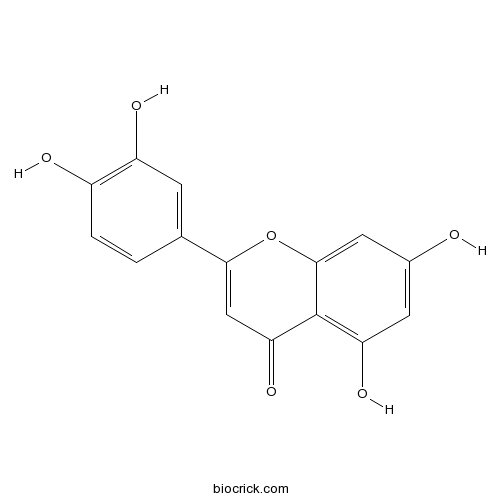A tetrahydroxyflavone in which the four hydroxy groups are located at positions 3', 4' 5 and 7. It is thought to play an important role in the human body as an antioxidant, a free radical scavenger, an inflammatory agent and an immune system modulator as well as being active against several cancers.
InChI=1S/C15H10O6/c16-8-4-11(19)15-12(20)6-13(21-14(15)5-8)7-1-2-9(17)10(18)3-7/h1-6,16-19H
Luteolin, is a common flavonoid that exists in many types of plants including fruits, vegetables, and medicinal herbs, has anti-oxidant, anti-inflammation, anti-allergy and anticancer, has been used in Chinese traditional medicine for treating various diseases such as hypertension, inflammatory disorders, and cancer. [1]
Luteolin can reduce production of proinflammatory mediators and inhibit LPS-induced IL-6 production in the brain by inhibiting the JNK signaling pathway and activation of AP-1 in microglia, also shows potent anti-inflammatory activities by inhibiting nuclear factor kappa B (NFkB) signaling in immune cells, thus, could be a promising candidate to develop immuno-modulatory and neuroprotective therapies for the treatment of neurodegenerative disorders.[2-3]
Luteolin induces apoptosis in various cancer cells, one mechanism through death receptor 5 (DR5) upregulation, treatment with luteolin might be promising as a new therapy against cancer. [4]
Luteolin attenuates TGF-β1-induced epithelial–mesenchymal transition of lung cancer cells by interfering in the PI3K/Akt–NF-κB–Snail pathway, strengthen the anti-cancer effects of flavonoid compounds via the regulation of migration/invasion and EMT ability of various cancer cells.[5]
[1] Lin Y, Shi R, Wang X, et al. Curr Cancer Drug Tar, 2008, 8(7):634-46(13).
[2] Jang S, Kelley K W, Johnson R W. P Natl Acad Sci USA, 2008, 105(21):7534-9.
[3] Dirscherl K, Karlstetter M, Ebert S, et al. J Neuroinflamm, 2010, 7(1):1-16.
[4] Horinaka M, Yoshida T, Shiraishi T, et al. Oncogene, 2005, 24(48):7180-9.
[5] Chen K C, Chen C Y, Lin C J, et al. Life Sci, 2013, 93(24):924-33.
[6] Chen X, Liu L, Sun Z, et al. Biomed Chromatogr, 2010, 24(8):826–32.



